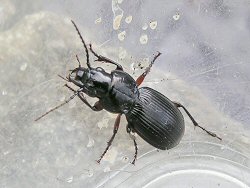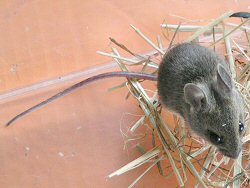For many of us, our gardens at nighttime are a mystery and yet there are many exciting animals that are more active at this time of day. For the determined garden naturalist, there are ways of taking a closer look at what's there.
Not so very long ago, a friend of mine came to my garden with some 'bat detectors' which are devices that pick up the ultrasonic echo-location vocalisations made by bats and transform them to a pitch audible to our ears.
 Ground beetle (possibly Feronia sp.) from a garden pitfall trap.
Ground beetle (possibly Feronia sp.) from a garden pitfall trap.
Although I regularly see bats in my garden, I was unprepared for the level of activity revealed by this equipment. We didn't
see a single bat whilst he was in the garden, but the bat detectors told a different story - they were never quiet. Evidently we were in the company of common pipistrelles (
Pipistrellus pipistrellus) virtually all the time. It brought home just how much is going on in the garden at night that we rarely get to experience.
Sometimes I use a few trapping techniques to look at nocturnal garden wildlife. With the warm weekend weather I decided to give a couple of them a go. The simplest of these are 'pitfall' traps which I make by burying jam jars so that their rims are flush with the soil surface - these are great for trapping nocturnal invertebrates. In the morning my traps yielded a number of beetles including this handsome ground beetle.
 Woodmouse (Apodemus sylvaticus) before its release back into the garden.
Woodmouse (Apodemus sylvaticus) before its release back into the garden.
If you use these traps on a night when there is a possibility of rain, you should prop a roof tile, or some other covering, over the top of the jar so that it doesn't fill with rain and drown whatever you catch. The cover should be propped high enough to give the invertebrates plenty of room around the trap.
I also have a couple of Longworth small mammal traps (a kind of 'humane' live trap often used by field ecologists) which I occasionally use in the summer months to get a close-up look at some of my garden mammals. The traps are provisioned with bedding and food. Because they may trap carnivorous shrews as well as vegetarian mice and voles, they must be provisioned with food suitable for both. I use bird seed mix for the mice and voles and a little bit of cat food for the shrews. This weekend one of my traps caught this woodmouse (
Apodemus sylvaticus) giving me a welcome chance to view this wonderful little animal up close for a few minutes before I released it. Note the large ears and eyes which make this animal almost unmistakable. Traps like these must be used responsibly. I restrict their use to warm nights when there is no danger of the animals suffering from the cold and I like to check them early the following morning.